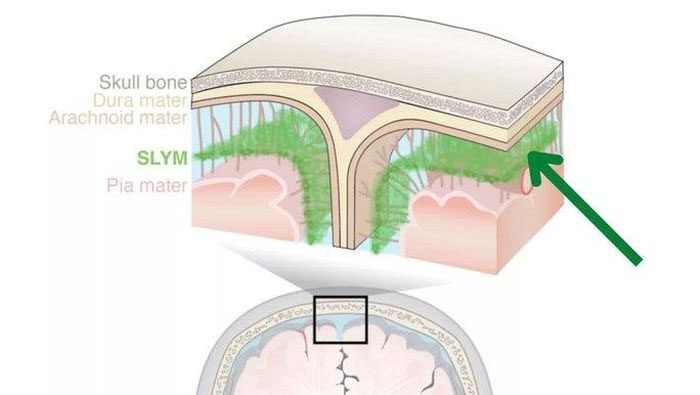A membrane-like structure previously unknown to humanity plays a crucial role in protecting gray matter, white matter, and is a mediator of metabolic exchange in the human brain.
According to Science Alert, researchers from the University of Copenhagen (Denmark) and the University of Rochester (USA) have identified a new structure they named “Subarachnoid Lymphatic-like Membrane” (SLYM) in the human brain, only a few cell layers thick.

Graphic showing the location of SLYM in the human brain – (Image: SCIENCE)
The research was primarily conducted on mice using two-photon microscopy and dissection, combined with other methods to confirm that this membrane also exists in the brains of adult humans.
SLYM protects gray and white matter and is located between two other protective membranes of the brain. It divides the subarachnoid space of our brain into two, raising the total number of known membranes in the human brain to four.
Additionally, SLYM plays a role in mediating the exchange of certain substances with low flow, dissolving between compartments in the brain. It appears to also serve as a foundation for specialized immune cells for the brain, not to mention supporting the brain’s waste clearance system.
“Physiological pulses caused by the cardiovascular system, respiratory system, and changes in head posture continuously shift the brain within the cranial cavity. SLYM – may – act like other mesothelial membranes, reducing friction between the brain and skull during such movements.” The researchers wrote in their publication in Science on January 5.
Small tears in SLYM – caused by traumatic brain injuries – may explain some long-term symptoms of such accidents, as they allow immune cells from the skull to directly access the brain without being calibrated to suit the condition of the human brain, resulting in increased inflammation.
As this “armor” of the human brain has just been discovered, scientists acknowledge that much work remains to fully understand it. Research on SLYM promises to bring more insights into the pathology of the human brain, paving the way for new treatment methods.


















































